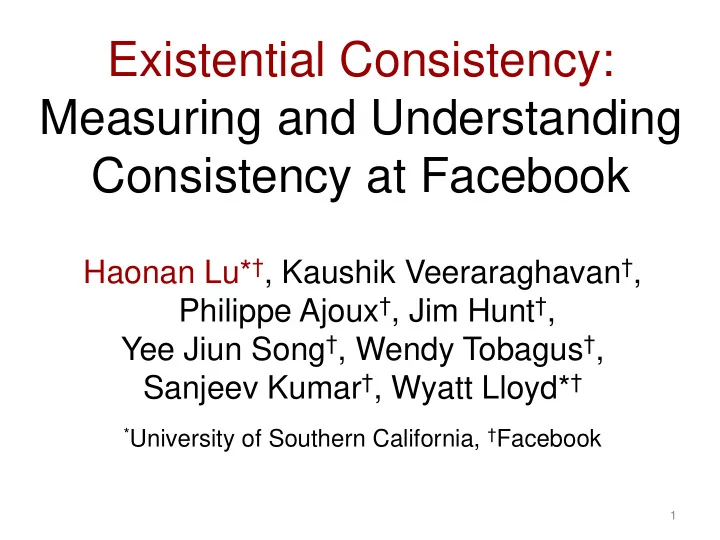

Existential Consistency: Measuring and Understanding Consistency at Facebook Haonan Lu* † , Kaushik Veeraraghavan † , Philippe Ajoux † , Jim Hunt † , Yee Jiun Song † , Wendy Tobagus † , Sanjeev Kumar † , Wyatt Lloyd* † * University of Southern California, † Facebook 1
2
3
Consistency Performance 4
Fundamental Tension Consistency Performance • Eliminates anomalies • Lower latency (Oculus example) • Makes systems • Higher throughput easier to program • Difficult to quantify • Simple to quantify First study of consistency in a large-scale, production system – Facebook TAO 5
Anomaly: Unexpected Behavior Post Example “Hey, I mentioned you in a post” New post “@Wyatt, Read friend’s timeline you should check out Old posts this game!” 6
Anomaly: Unexpected Behavior Oculus Example 1. “Mine! yeah~ lucky!” 1. “I wouldn’t mind…” 1. “I wouldn’t mind…” 2. “ Mine! yeah~ lucky! ” 7
Does Facebook have consistency anomalies? How many? What type? 8
TAO: Eventually Consistent Cache Vulnerability window: time during asynchronous replication when anomalies can happen new post B read done value A C old post M 9
Quantifying Anomalies • How often do anomalies occur? – Collect trace of requests to TAO • What consistency would prevent them? – Run anomaly checkers on the trace 10
Trace Collection • Collect trace on web servers • Challenges in tracing production system – Volume of requests – Time skew between web servers – Missing requests 11
Challenge: Volume of Requests • Billions of requests per second [ ATC ’13 ] – Too many to log • Sample on objects – Object: vertex in social graph – Log all requests to objects in sample – Sufficient for local consistency models 12
Local Property Enables Sampling • “… the system as a whole satisfies P whenever each individual object satisfies P .” [1] Local consistency models can be checked on a per object basis • Local – Linearizability – Per-Object Sequential – Read-After-Write [1] M. P. Herlihy and J. M. Wing “Linearizability: A Correctness Condition for Concurrent Objects.” ACM TOPLAS, 1990 13
Challenge: Time Skew • Time skew across web servers – 99.9 percentile for 1 week: 35ms • Add time skew to request’s duration – More overlapped requests – Eliminates false positives 14
Logging Details • Logged information: – Start time – Start time Determine real time ordering of requests – Finish time – Finish time – Read or write – Read or write Post (new) – Value: match read with write – Value: match read with write • Sampling rate: 1 out of 1 million objects ~ 100% of requests to sampled objects 15
Trace Statistics • 12 days (8/20 – 8/31) • 17 million objects • 3 billion requests 16
Check Trace for Anomalies • Linearizability checker – Paxos provides • Per-Object Sequential checker – PNUTS provides • Read-After-Write checker – TAO provides within a cluster 17
Linearizability • Strongest non-transactional consistency – Real-time constraint Should return • Post example “new” Post (old) Post (new) Read (old) Haonan Haonan Wyatt – Total order constraint • Oculus example! 18
Linearizability Checker • Graph captures state transitions – Vertex: write operations – Edge: real-time order • Merge read with its write – Captures state transitions seen by users • Anomaly if merge causes a cycle – Cycle indicates user’s view ≠ system view 19
Linearizability Checker • Captures real-time constraint – Read should return new post instead Post (old) Post (new) Read (old) Haonan Haonan Wyatt Should return new post Post Post Read (new) (old) (old) 20
More Complex Cases http://tinyurl.com/sosp15-demo w(0) r(1) w(1) w(2) w(3) r(2) r(3) r(3) r(2) r(1) 21
Result Overview • Linearizability • Per-Object Sequential • Read-After-Write • Bounds on non-local consistency models Anomalies found for all consistency models – adopting them would have benefits 22
Linearizability Results • 5 anomalies per million reads – Prevented by Paxos-based implementation • Upper bound on TAO anomalies – Strongest consistency we checked TAO is highly consistent 23
Linearizability Results Real-Time Constraint Violations • 4 per million reads Post (new) Read Post (new) Post (new) A B starts finishes M Replica A: Master M: Replica B: Read (old) 24
Linearizability Results Total Order Constraint Violations • 1 per million reads Comment(W) Comment(H) B A H starts H finishes Read (H) M Replica A: Master M: W H Replica B: Read (W) W finishes W starts 25
Per-Object Sequential Results • 1 anomaly per million reads – Total order constraint – User session constraint (1 per 10 million) • Users should see their writes Read Post(new) B A Old M 26
Infer Bounds on Causal Linearizability Superset of causal anomalies 5 per million reads ≤ 5 per million reads Causal ≥ 1 per million reads Per-Object Sequential Subset of causal anomalies 1 per million reads 27
Lower Bounds on Transactions Strict Serializability > 5 per million reads Future research should Linearizability provide transactions 5 per million reads Causal with Transactions Causal > 1 per million reads Per-Object Sequential 1 per million reads 28
Real-Time Consistency Monitor • Checkers cannot run in real-time • Φ -consistency – Measure convergence of replicas • A real-time health monitor – Alarms when a replica falls behind 29
Conclusion • Benefits of consistency are hard to quantify – First study of a large-scale production system • Measure Facebook’s TAO system – Collect trace and run anomaly checkers – Real-world challenges • Results – TAO is highly consistent – Benefits of adopting stronger consistency exist – Research should provide transactions 30
Recommend
More recommend